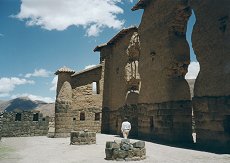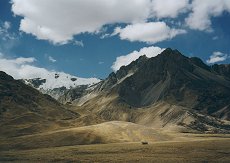Page
8
After
the organised part of the holiday we had a free day in Cusco to organise bus and
plane tickets, hotels and trips for our remaining time in Peru and then have a
final meal with our Naturetrek group. They
departed for Lima and then London while we were off by coach to Puno and Lake
Titicaca. The coach was
comfortable and the driver amazingly considerate and careful; the ‘guide’
spoke broken English and only briefly. Our
first stop was at a small, dusty village square (Andahuaylillas) with a fine C17
Church lined with beautiful frescoes, a splendid wooden door and an ornate
gilded main altar. Sadly, our 35
soles entry fee won’t halt it falling into gentle dusty disrepair.
Next stop an altogether
 more impressive old Inca site –
Raqchi, where the central wall of an enormous temple is still standing.
It had black, volcanic masonry below and adobe bricks above as well as
the circular stone bases of the pillars that had once supported the roof. To one
side the remains of 200 circular storehouses and beyond row upon row of neatly
lined-up buildings. I bought an explanatory booklet in English, but was little
wiser after reading its ‘literal’ translation!
more impressive old Inca site –
Raqchi, where the central wall of an enormous temple is still standing.
It had black, volcanic masonry below and adobe bricks above as well as
the circular stone bases of the pillars that had once supported the roof. To one
side the remains of 200 circular storehouses and beyond row upon row of neatly
lined-up buildings. I bought an explanatory booklet in English, but was little
wiser after reading its ‘literal’ translation!
Back
on the coach and a continual drive upwards, the landscape becoming treeless and
more arid until we reached a high pass at 4,200 metres with snow-capped
mountains on each side. A lonely
but majestic area. The high
alti-plano is vast; great valleys with sparse vegetation, brown scrub barely
supporting flocks of sheep, cattle and llamas.
Smallholdings made of adobe bricks sit isolated in the landscape.
Then it was down towards Puno, a sprawling ugly, dirty place with many
unfinished buildings and narrow streets.
Had a superb Pizza in a tiny restaurant, met our fellow travellers in the
main street and said yet another ‘Goodbye ….’
is vast; great valleys with sparse vegetation, brown scrub barely
supporting flocks of sheep, cattle and llamas.
Smallholdings made of adobe bricks sit isolated in the landscape.
Then it was down towards Puno, a sprawling ugly, dirty place with many
unfinished buildings and narrow streets.
Had a superb Pizza in a tiny restaurant, met our fellow travellers in the
main street and said yet another ‘Goodbye ….’
Up
early the next morning as our schedule included a boat trip to the Floating
Islands and a trip to the tiny island of Taquile for an overnight stay.
In the Harbour we spotted one of the two old ships that were transported
by donkey to Lake Titicaca in 1870 in over 2,000 pieces!
(It’s now a Red Cross / Hospital ship)
A fleet of small boats were moored together and after much reference to
grubby bits of paper and lists, our group was gathered onto one of the slowest,
oldest boats. The Captain was a short, frowning, mahogany weathered, slitty-eyed
character who spoke no English and blustered about the boat.
A car engine, started by key sprang into life – the wooden covering
open to let out fumes into the lungs of the passengers.
Off we chugged through a narrow reed channel full of birds; heron, coot,
moorhen, Pintail ducks, small fluffy-bottomed grebes with white eye patches,
Black Ibis, seagulls and Phalarope. ( No bird guide here, so species unknown!)
Our boat was definitely slower than the rest, and eventually we reached
one of the Uros Islands. These
islands are just floating bed s of reeds staked to the shallow lake bottom, and
needless to say – for Tourist eyes only!
Groups of women sat around hoping to sell their miniature reed boats,
friendship bracelets and craft items. The
small reed houses didn’t look more than day-time resting shelters to me,
although we were assured that people lived on the islands but I couldn’t see
any TV aerials, so didn’t believe everything I was told!
With passengers collected once again we chugged off for Taquile, all the
other boats soon way ahead of ours. Then
phut! phut! and the boat stopped! The
wrinkled old Captain looked worried, somewhere there was a blockage and the
engine was overheating. He poured a
jug of cold lake water into an outlet hose and then blew hard into it, looked
puzzled and more worried. The cold water and blowing treatment was repeated for
45 minutes until the engine once again sprang into desultory life for the three
hour trip to the island! The
setting of the lake is quite beautiful in the clear, pure air of high altitude
and surrounded by snow-capped mountains. Finally,
we arrived at a small jetty on Taquile and piled out.
The island looked quite dry and barren, the once neat terracing now
falling into disrepair although there were some ‘fields’ that had been
turned over ready for sowing. Apparently the locals were waiting for the overdue rains
before planting their crops. We
walked up the only path, towards the only village past short women with dark
sunburned skin. They wore skirts
down to the knee, fully gathered at the waist making them look even shorter and
black shawls over their heads. Most
seemed to have absurdly large bosoms and they worked as they walked – spinning
wool!
s of reeds staked to the shallow lake bottom, and
needless to say – for Tourist eyes only!
Groups of women sat around hoping to sell their miniature reed boats,
friendship bracelets and craft items. The
small reed houses didn’t look more than day-time resting shelters to me,
although we were assured that people lived on the islands but I couldn’t see
any TV aerials, so didn’t believe everything I was told!
With passengers collected once again we chugged off for Taquile, all the
other boats soon way ahead of ours. Then
phut! phut! and the boat stopped! The
wrinkled old Captain looked worried, somewhere there was a blockage and the
engine was overheating. He poured a
jug of cold lake water into an outlet hose and then blew hard into it, looked
puzzled and more worried. The cold water and blowing treatment was repeated for
45 minutes until the engine once again sprang into desultory life for the three
hour trip to the island! The
setting of the lake is quite beautiful in the clear, pure air of high altitude
and surrounded by snow-capped mountains. Finally,
we arrived at a small jetty on Taquile and piled out.
The island looked quite dry and barren, the once neat terracing now
falling into disrepair although there were some ‘fields’ that had been
turned over ready for sowing. Apparently the locals were waiting for the overdue rains
before planting their crops. We
walked up the only path, towards the only village past short women with dark
sunburned skin. They wore skirts
down to the knee, fully gathered at the waist making them look even shorter and
black shawls over their heads. Most
seemed to have absurdly large bosoms and they worked as they walked – spinning
wool!
It
was a 30 minute climb up to the large but drab Plaza de Armas ;
where a political meeting was in full flow. All the men in the square wore floppy hats and the women all
had on black shawls. We found out
from our guide that hats were a major indicator of social and marital status
among the islanders.  Shaped rather
like a very long sock, they were worn with the floppy bit over the left ear or
right ear or even flapping behind; some were plumped up with coca leaves, others
quite droopy and a few risqué ones were folded up and plonked on top of the
head - it doesn’t take a lot of imagination to know what interpretations went
through our minds! Anyway, the
political meeting had something to do with voting in a committee to run the
affairs of the islands. Our
original idea had been to stay overnight on the island with a local family, but
after seeing how primitive the housing was, we decided to return on the boat to
a decent hotel bedroom and en-suite!
We had a non-memorable lunch then idled our way back down the other side
of the island to the waiting boat and a very worried-looking Captain.
It wasn’t long before we realised why he was worried; the lake had
‘roughed up’ considerably with waves 3 – 4 ft. high and the little engine
struggled to make headway and darkness was approaching.
Not a single light lit the boat, nothing inside, nothing outside - not
even the moon. We made slow
and anxious progress back to Puno, arriving cold through but relieved to be
back. (We had booked this
trip while in Cusco and had been charged $71 each for it, others on the same
trip paid $15!!! More on that
scam, later.)
Shaped rather
like a very long sock, they were worn with the floppy bit over the left ear or
right ear or even flapping behind; some were plumped up with coca leaves, others
quite droopy and a few risqué ones were folded up and plonked on top of the
head - it doesn’t take a lot of imagination to know what interpretations went
through our minds! Anyway, the
political meeting had something to do with voting in a committee to run the
affairs of the islands. Our
original idea had been to stay overnight on the island with a local family, but
after seeing how primitive the housing was, we decided to return on the boat to
a decent hotel bedroom and en-suite!
We had a non-memorable lunch then idled our way back down the other side
of the island to the waiting boat and a very worried-looking Captain.
It wasn’t long before we realised why he was worried; the lake had
‘roughed up’ considerably with waves 3 – 4 ft. high and the little engine
struggled to make headway and darkness was approaching.
Not a single light lit the boat, nothing inside, nothing outside - not
even the moon. We made slow
and anxious progress back to Puno, arriving cold through but relieved to be
back. (We had booked this
trip while in Cusco and had been charged $71 each for it, others on the same
trip paid $15!!! More on that
scam, later.)
Home
Page 1 Page 2
Page
3 Page 4
Page
5 Page 6
Page
7 Page 9
Page 10 Page 11
 more impressive old Inca site –
Raqchi, where the central wall of an enormous temple is still standing.
It had black, volcanic masonry below and adobe bricks above as well as
the circular stone bases of the pillars that had once supported the roof. To one
side the remains of 200 circular storehouses and beyond row upon row of neatly
lined-up buildings. I bought an explanatory booklet in English, but was little
wiser after reading its ‘literal’ translation!
more impressive old Inca site –
Raqchi, where the central wall of an enormous temple is still standing.
It had black, volcanic masonry below and adobe bricks above as well as
the circular stone bases of the pillars that had once supported the roof. To one
side the remains of 200 circular storehouses and beyond row upon row of neatly
lined-up buildings. I bought an explanatory booklet in English, but was little
wiser after reading its ‘literal’ translation!

